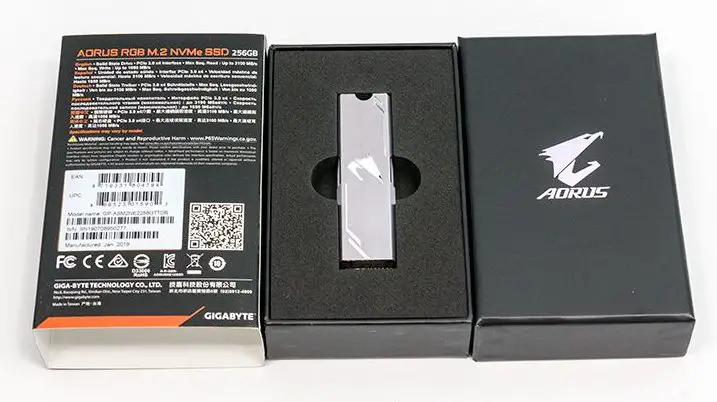The Gigabyte Aorus RGB NVME solid state drive does prove Gigabyte is serious about Solid-State Drives and offering their customers unique solutions. This fresh perspective may not be perfect but it does have a lot more going for it than the typical drive. For example, by not only including a good heat spreader but a drive with integrated LEDs the Aorus RGB NVME can potentially enhances a custom system’s overall build in ways that the typical SSD cannot. This outside the box thinking is refreshing in a market that seems dead set on only offering utilitarian options to buyers.
Equally important, Gigabyte were not only concerned with the aesthetics of their drive but also its performance. By opting for a combination of the Phison E12 controller paired to Toshiba BiCS 3 TLC NAND, buyers really need not worry about performance. This is a proven combination which provides good performance at great asking prices. However, much like the exterior, Gigabyte has put their own spin on the typical configuration. One that may miss its intended mark but shows Gigabyte is just as serious about performance as they are looks. They simply need more experience in what works and does not work in the real world.
This lack of experience with NVMe M.2 drives did cause another misstep or two. The first is the capacity options. By opting for lower density NAND ICs, Gigabyte was limited in the total capacity they could offer. We understand why they did not want to stack the NAND ‘chips’ as high as most E12 designs, to keep temperatures in check, and we are impressed they had this level of insight. Insight that does seem to escape even more experienced manufactures. However, by opting for lower density NAND ‘chips’ Gigabyte was forced to use both sides of the small M.2 PCB, even on their smaller 256GB model.
Since the included heat spreader is a single sided cooling only design, half the NAND ICs are left to their own devices. Few motherboards, and fewer PC builds can actively cool the back of the M.2 PCB. This misstep means that while these lower density NAND chips will shed heat faster than most, thermal limiting will occur more than the included heat spreader would lead you to believe. We doubt the typical home-user will ever have their drive thermally limit long enough to be noticeable, but it is a potential issue you need to be aware of before you buy.
As this is a PHISON E12 based drive, consumers need to also be aware that there is a rather large difference in performance between the 256GB and 512GB capacity models. This is the downside to opting for the Phison E12 controller and Phison bog-standard firmware. Phison really did design the E12 around at least 512GB’s worth of TLC NAND being attached to the controller. A more experienced company would have been aware of this and either modified the standard firmware to minimize this performance impact or given serious consideration to other possible solutions (e.g. SMI controller options).
Lastly, and most importantly, this SSD may indeed come with RGB LED’s integrated directly on to the PCB, but is really only (easily) controllable when used on Gigabyte motherboards. This will be a deal-breaker for many.
As such it is best to consider the Aorus RGB NVME a great ‘proto’ Gigabyte NVMe SSD. One that Gigabyte did use to learn and gain much needed experience, but one that is not as refined or razor sharp as more experienced manufacture’s options. This is not to say that the Aorus RGB NVME is a bad drive. Just one that could have been easily one of the best value SSDs available. Instead its slightly eccentric design may make it less than optimal for some builds.
In conclusion the Gigabyte Aorus RGB NVME is not perfect. It however is a purchase where you can get good performance, excellent aesthetics, and do so at a very reasonable asking price. So, if you are looking for a good NVMe SSD and spot one of these older Aorus RGB NVME’s for sale you really should give careful thought about opting for it over one of the ‘usual suspects’ offerings. Just get the 512GB version and skip the 256GB capacity option.
The Review
Gigabyte Aorus RGB NVMe 256GB M.2
The Gigabyte Aorus RGB NVME solid state drive does prove Gigabyte is serious about Solid-State Drives and offering their customers unique solutions. This fresh perspective may not be perfect but it does have a lot more going for it than the typical drive.











